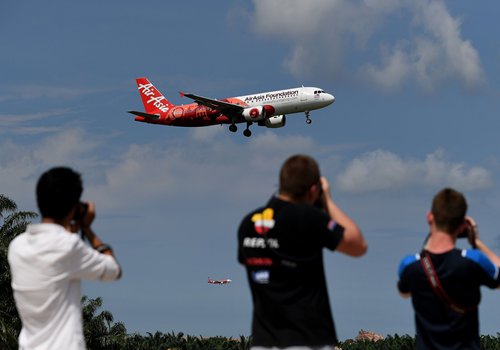Low-cost carrier AirAsia faces challenges establishing China’s 1st foreign JV airline
Expanding on a budget

Plane spotters take photographs of an AirAsia aircraft as it prepares to land at a Malaysian airport in May. Photo: CFP
AirAsia, the largest low-cost carrier in Asia is planning to expand into China by setting up a joint venture (JV) in Zhengzhou, capital of Central China's Henan Province, without a Chinese airline as a partner.
If successful, AirAsia's venture in China, called AirAsia (China), would be the first foreign JV passenger airline in the country.
The Malaysian airline's ambition is obvious. As a giant in the budget airline market, it has built its presence in Malaysia, Indonesia, the Philippines, India, Thailand and Japan. However, even as it is about to copy its successful model in China, it faces hurdles beyond approval procedures.
Its first challenge will be winning Chinese regulators' approval. In May, AirAsia signed a memorandum of understanding with China Everbright Group and the Henan provincial government to establish AirAsia (China).
Currently, there are more than 40 airlines in China. The Civil Aviation Administration of China (CAAC) has not approved any new airlines since September 2015. It's difficult to say whether a JV could get regulatory approval due to the strict rules.
The CAAC has strict rules for foreign airline investment, requiring that Chinese partners have a controlling stake in any JV airline. It also requires that foreign companies, including their affiliates, have no more than a combined 25 percent stake in an airline JV. Under these rules, AirAsia would hardly have a say in running its JV. By comparison, AirAsia's stakes in its JVs in Indonesia, India and Japan all exceed 40 percent.
In China, the convenient location of Zhengzhou is a double-edged sword.
On one side, Zhengzhou provides AirAsia with a strategic location and access to an important logistics hub, said AirAsia Group CEO Tan Sri Tony Fernandes. "As China's gateway to Europe, Zhengzhou sits at the center of a vast rail, highway and air transport network that forms the linchpin of China's development plans for its central and western regions," he was quoted as saying in a press release on May 14.
However, the location also poses a challenge for airlines flying short- and medium-haul routes because of competition from China's extensive high-speed rail system.
For example, a train ride from Zhengzhou to Shanghai takes only four hours and costs 450 yuan ($66.21), posing a big challenge for any low-budget carrier. In comparison, the cheapest air ticket is 460 yuan when departing from Zhengzhou to Shanghai on Friday.
In 2008, Spring Airlines also vowed to set up a base in Zhengzhou, but went on to suspend all routes in March 2009 due to inefficient transport capacity and limited slots. It didn't resume those routes until 2015.
Fernandes said China represents the final piece of the AirAsia puzzle, as China is an important market with the biggest potential for the low-cost carrier.
AirAsia entered China in July 2004 with a route in Macao. It accelerated its expansion in 2012, opening eight routes, starting with Beijing to Kuala Lumpur, capital of Malaysia. The next year, it opened five routes between Shanghai to Kuala Lumpur. Currently, AirAsia and AirAsia X fly to 15 destinations in China, making AirAsia the largest foreign airline operating in the country.
At the end of 2014, Fernandes told the media that for all the destinations in China, 52 percent of the country's second-tier cities have never been served by any airline, ever.
After setting up the JV, AirAsia will have more opportunities to open routes in China, giving passengers in third- or fourth-tier cities the chance to fly overseas.
However, domestic carriers will pose a challenge. China has fewer than 10 low-budget airlines, including Spring Airlines, China West Air and China United Airlines.
Of those, Spring Airlines has the largest fleet, with more than 70 Airbus planes.
Spring Airlines went public in 2011. Its revenue grew to 8.43 billion yuan in 2016, according to its latest financial report. The airline vowed to expand into more markets in northeastern and southeastern Asia.
Low-budget airlines, including Spring Airlines, account for less than 10 percent of China's airline market, according to media reports. By comparison low-budget carriers have more than 60 percent of the market in Southeast Asia and 40 percent in Europe.
In 2014, the CAAC vowed to help China's low-budget airlines grow, but few supportive measures have come out thus far.
At the same time, limitations in terms of slots, pilots and the introduction of aircraft are further hindering low-cost airline from expanding rapidly. For a newcomer, it is difficult yet essential to obtain a popular arrival and departure slot.
Furthermore, airlines in China are not allowed to charge for seat selection, which is an important source of revenue for budget airlines.
However, even with these challenges, AirAsia (China) maintains its confidence, saying it will invest in aviation infrastructure, including a dedicated low-cost carrier terminal at Zhengzhou airport and an aviation academy to train pilots, flight crew members and engineers, as well as maintenance, repair and overhaul facilities to service aircraft.
Good luck!

